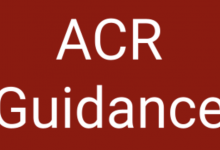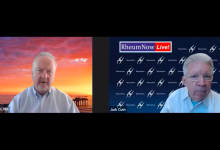The Story Teller (Best of 2017) Save

Angie is my last patient before lunch. I've known her since her RA diagnosis at age 17 years. And for the last 7 years, she’s matured into a fabulous young woman who has adeptly grown her professional life, her dating life and developed her independence, despite her severely active rheumatoid arthritis.
But today I see she has a troubled and anxious look as I greet her. I asked her “what's up”? She says. “oh Dr.Cush everything's wrong. My boss is hassling me, my mother won’t let me move out, my father is throwing a fit and my boyfriend's a pain in the butt”.
Therefore, I let her angst soak in a bit and let her brew, as I set up the EMR. Finally, I turn to her and say, “With all this bad luck you should go out and buy a lottery ticket”. To which she says nothing, but her face transforms, her eyes widen and I can see her mental wheels are spinning. As she's pondering this potential new change of fate, she almost smiles. I ask her, "So Angie, when you win the lottery, what's the first thing you're going to buy”? She hardly misses a beat and says, “If I win the lottery, the first thing I'm going to get is a real rheumatologist”!
We both laughed hard and I beamed as a proud co-conspirator and a resilient humorous tease from a woman of substance, immeasurable fortitude and grand sense of self.
This is my favorite story. It’s about the power of good humor, good communication and an honest relationship with my patient, who surprisingly turned her worries into optimism and a good laugh at my expense!
We all have our great stories from our world of medicine and patient care. Our days are fast read of challenge, personal heartache, failures, shock, joy, success, and more. It is not surprising that each of us has the tales to tell that are either lifes great lessons, teaching vignettes or griping anecdotes dying to be shared.
Story is the most effective and impactful way we can communicate with ourselves, our peers and our patients.
- You're hung up in traffic and as you inch around a roadside scene (dictated by weather, vehicles, parts, people, police) your mind begins to creates the story that you can tell your spouse when you get home.
- My grandfather had advancing lung disease but was still smoking. He went to his pulmonologist who simply took a large square napkin and said “this is a normal lung”. He then folded the napkin 3 times (now 1/8th the size) and said, “This is YOUR lung”. My grandfather threw away is full pack of cigarettes as he left the doctor’s office.
- When you transfer your patient to the care of a consultant, you don’t read from the chart and you don’t wax on about the trend in chloride levels – you tell a concise story that has a presentation, problem(s), twist and status or outcome.
- Your severe tophaceous gout patient needs to start IV Pegloticase. You could discuss clinical trial results, quote the risk of flare, lab abnormalities and give a 3 page drug information sheet. Or you could also tell a story of the last one or two patients who were in this situation and went on to receive IV therapy. Such a story has a beginning (profile), middle (numerous failed treatments and need for newer options) and end (treatment experience and outcomes 1 year later).
Our brains are hardwired to receive and understand story. Whether you’re a parent, sales person, physician or politician – story is a highly effective mode of explaining, engaging by being relateable and changing behavior. All stories are essentially a three act play.
Analogies to the Three Act Play (Story)
- 1st Act (set up), 2nd act (conflict) and 3rd act (resolution)
- Beginning - Middle - End
- Thesis – Antithesis – Synthesis
- Backstory (context) – Conflict (problem, challenge) – Resolution (takeaway)
- One author says his approach is to “Find the hurt, amplify the pain, and then heal the wound”.*
Story is pervasive. The modern day sitcom is based on a 22 minute 3 act play. Eight-minute interviews with celebrities on television have a 3-part formula. This same pattern of communicating (and learning) is replete and works.
You should seriously work at your stories; in your teaching, patient communications or even to develop as an avocation.
For those who want to focus on story telling:
- All stories have a - Beginning, Middle and End (as described above)
- Use: And – But – Therefore. These 3 terms can be used to tell a story; even within the same sentence. “Mike and I are longtime friends and grew up in an orphanage, but yesterday Mike wins the Academy Award; now (therefore) I only get to see Mike on television”. The above story about my patient Angie was written using And-But-Therefore as a guide.
- Start with the end in mind. Know the punch line, teaching point, take-home message and then build your beginning (setup) and middle (that should contain the conflict, problem, or plot twist).
A recent JAMA article on “Stories Doctors Tell” examines physician narrative anecdotes and reflections from several journals. They noted that these stories conveyed 5 lessons: 1) the practice of medicine is a privilege; 2) patients are vulnerable; 3) physicians are fallible; 4) humanity matters; and 5) the system is flawed. This is what appears when doctors tell their stories in medical journals (https://buff.ly/2wsAAiM).
Another recent JAMA article reports that “Storytelling is medicine’s currency”. “Sharing and Healing through Storytelling in Medicine” presents a physician storying telling forum called the Nocturnists (in San Francisco), that typifies the importance of storytelling in medicine. (https://buff.ly/2xCeXl6)
This focus on story telling was brought to my attention by fellow rheumatologist, Dr. Ronan Kavanagh. Ronan is a great writer and story teller who is leading a physician story telling event in Galway this December. Ronan is a co-organiser of the Dublin based annual Festival of Medical Curiosity - The dotMD Conference. He has also organized this event dedicated entirely to physician storytelling, called Bedside Stories (WWE.Bedside.ie).
According to Ronan, “The Bedside Stories event is an effort to use stories to celebrate the human side of medicine, as a tonic to some of its frustrations, and also to help generate a sense of community and fun around learning. We also hope that the sharing of stories will help go some way to help preventing symptoms of burnout and isolation."
The event, which will take place in Galway in December this year, will feature stories from a doctors working in general practice, psychiatry, and public health and hospital medicine and will also feature live music. Sign up at www.bedside.ie or follow @bedsiders for updates.
*For those interested in hearing more about “Story” I highly recommend listening to this podcast from Social Media Examiner










If you are a health practitioner, you may Login/Register to comment.
Due to the nature of these comment forums, only health practitioners are allowed to comment at this time.